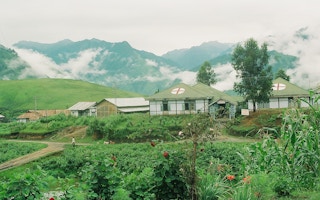The perennial problem of power cuts in India makes the storing of blood for transfusions virtually impossible in rural areas, forcing seriously ill patients to travel many miles for treatment. But now an experiment with solar power in a remote Himalayan hospital has changed that.
The erratic electricity supply in the Ziro Valley’s Hapoli general hospital, in the Himalayan state of Arunachal Pradesh, northeastern India, meant that its blood bank could not operate as its stock needs to be kept at a constant 2°C to 6°C.
The hospital, at an altitude of 5,357 feet, is about five-hour drive away from the state capital, Itanagar. The area is heavily dependent on the central grid as it does not produce enough of its own power, and many areas in the mountains are still without any electricity supply.
But with India rapidly increasing the use of solar power to meet its climate change commitments, costs are coming down, so Hapoli hospital decided to experiment to see if it could use solar electricity to get a stable supply to store blood and also to carry out the necessary tests to screen for diseases.
Medical facilities
The blood bank was started in October last year with a private sponsor for a five-kilowatt solar power system. It provided enough power to make blood tests and storage possible, and the idea is now being extended within this hospital and in many other more remote medical facilities across India.
Dr Joram Khopey, the blood bank officer at Hapoli hospital, says: “Screening tests for transfusion-transmissible infections − especially HIV, Hepatitis B, Hepatitis C, syphilis and malarial parasites − are carried out before blood is okayed for transfusion. The results take three days and, with no refrigeration, it would not be possible to store the collected blood units for future use.”
Before the blood bank started, patients were referred to a tertiary care hospital if they needed blood, and that meant at least half a day’s journey. So many went directly to hospitals in bigger towns in the neighbouring state.
With the solar-powered facility, the local population can now look forward to not having to send patients − including pregnant women needing Caesarian sections − to faraway places because of the lack of blood stocks.
Not that the idea caught on instantly. Only four people came forward at a blood donation camp held last December. But more volunteered later and, by January, a total of 14 units of blood were received. Five of these were used in transfusions, so the project was deemed a success.
Dr K Horming, medical superintendent at Hapoli hospital, says: “The government has now sanctioned solar panels for 10 kilowatt power generation for the hospital’s delivery, emergency, immunisation, occupational therapy, and the nurses’ rooms.”
In addition, the Arunachal Pradesh state government has incorporated plans for solar-powered blood banks for its two general hospitals and 13 district hospitals. “We have already sanctioned funds for it in the 2016-17 budget,” says Ramesh Negi, Arunachal Pradesh’s chief secretary.
Good option
Of the 650 districts in India, about 60 do not have a blood bank because of lack of electricity or human resources. But that will now change.
Dr Apurba Ghosh, secretary general of the Federation of Blood Donor Organisations of India, says: “Solar energy can be a good option to run those blood banks waiting for power among these 60 districts. We can now aim for more blood banks across the country.”
India has 2,760 recognised blood banks for a population of approximately 1.25 billion, and most of the blood banks are in urban or metropolitan centres.
Mobile solar panels can also be used for cooling blood in donation camps held in rural areas.
The Indian government has endorsed this idea. Dr Manisha Srivastava, a member of the Ministry of Health and Family Welfare Technical Resource Group on blood transfusion, says: “This will be really useful for remote areas, which have a perennial power shortage.
“The blood storage centres in the plains will be run on solar energy (using portable photovoltaic panels), and for those in the hills there can be a combination of solar and ice-lined boxes.”










